
Kentrosaurus
Spiky guardian of the Jurassic sea.
Period
Jurassic
Length
Measured about 4.5 meters in length.
Height
Stood around 2 meters tall at the hips.
Weight
Weighed about 1-2 tons.
Kentrosaurus was a herbivorous dinosaur from the Late Jurassic period, recognized for its distinctive plates and spikes along its back and tail. Its name means 'sharp-pointed lizard' and reflects its unique defensive features. Living in what is now Tanzania, it roamed lush prehistoric landscapes, relying on its armored body for protection against predators. Kentrosaurus is a fascinating example of the diverse evolutionary strategies that dinosaurs employed for survival.
Diet
Kentrosaurus primarily fed on low-lying plants and foliage. Its beak-like mouth helped it grasp and tear leaves and ferns efficiently for consumption.
Hunting
As a herbivore, Kentrosaurus did not hunt. Instead, it grazed peacefully in groups, relying on plant availability for sustenance. Its presence in herds suggested a social structure that could deter predators.
Environmental challenges
Kentrosaurus lived in environments rich with vegetation, which could vary from wet to semi-arid conditions. Seasonal changes and competition for food sources might have posed significant challenges. The presence of large predators in its habitat required it to be vigilant, using its spikes for defense against potential threats.
Speed
Slow-moving, approximately 5-7 kilometers per hour.
Lifespan
Estimated around 20-30 years.
First discovery
Discovered in Tanzania in 1909 by a German expedition.
Fun Facts
- Kentrosaurus lived during the Late Jurassic period, around 150 million years ago.
- It was a plant-eating dinosaur with a series of distinctive spikes along its back and tail.
- Kentrosaurus was relatively small compared to other dinosaurs and measured about 15 feet in length.
- The name 'Kentrosaurus' means 'pointed lizard,' which refers to its sharp spikes.
- Kentrosaurus fossils were first discovered in Tanzania, Africa.
- Its tail was very flexible and could be used as a powerful weapon against predators.
- Despite its fearsome appearance, Kentrosaurus was a herbivore and primarily fed on low-growing plants.
Growth and Development
Young Kentrosaurus likely grew rapidly to reach size sufficient to deter predators. Its development from hatchling to adulthood involved the gradual growth of its protective armor. As with many dinosaurs, social interactions within groups may have supported its growth and survival.
Habitat
Kentrosaurus inhabited woodland areas with plenty of ground-level vegetation in what is now eastern Africa. These environments were conducive to its herbivorous diet and social lifestyle. The presence of rivers and floodplains also provided essential water sources and lush plant growth.
Interaction with other species
Kentrosaurus likely coexisted with other herbivorous dinosaurs, competing for similar food sources. Its defensive spikes would have been a crucial feature for deterring carnivorous threats. It might have formed mixed herds with other species for added protection.
Natural lifespan
The natural lifespan of Kentrosaurus was likely around 20-30 years.
Reproduction
Kentrosaurus likely reproduced by laying eggs, possibly in communal nests. Parental care was minimal, as with many dinosaurs, though nesting in groups could offer some safety to the young. Hatchlings were thought to be precocial, capable of moving shortly after birth.
Social behaviour
Kentrosaurus was likely social, living in groups that provided collective defense against predators. Its social structure might have involved complex interactions within herds, such as coordinated movements or signals to communicate danger. Living in groups helped distribute surveillance duties and reduce individual risk.
Fossil locations
Kentrosaurus fossils have predominantly been found in the Tendaguru Formation in Tanzania. These findings have offered critical insights into the diversity of Jurassic African faunas. Ongoing excavation efforts continue to reveal the extent and nature of its environment.
